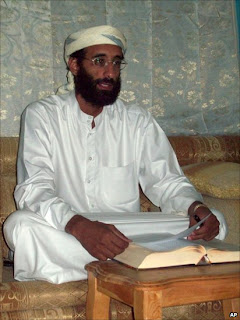The killing of Anwar al-Awlaki. A crippling blow - Oct 1st 2011.
THE successful drone strike that on September 30th killed Anwar al-Awlaki and at least four other senior operatives from al-Qaeda’s Yemen-based franchise (known as al-Qaeda in the Arabian Peninisula, or AQAP) may turn out to be even more significant than the raid on Abbottabad that ended the life of Osama bin Laden. Although bin Laden’s death was a cathartic moment for most Americans, and the special forces that swept through his squalid lair carried off an intelligence treasure trove, al-Qaeda’s embattled leader had been a busted flush, from an operational point of view, for some time. “Core” al-Qaeda, the original bit of the organisation that hangs out in Pakistan’s tribal areas is also, according to the White House’s anti-terror chief, John Brennan, “on the ropes”. Until yesterday, however, the same could not have been said of AQAP, which intelligence sources have regarded for a while as the branch of the terror network that posed the greatest direct threat to the West.
That was partly due to the ability of the American-born al-Awlaki, a smooth and articulate polemicist, to tickle the
erogenous zones of disaffected young Muslims in Europe and America. He would capture their imaginations, persuade them to come to Yemen for training and then send them home as “lone wolf” terrorists ready and waiting to strike. Alone among al-Qaeda propagandists, al-Awlaki was not blindsided by the Arab spring. In this enterprise, al-Awlaki was assisted by his fellow American jihadist, Samir Khan, the web-savvy editor of the organisation’s online magazine “Inspire”, who was also killed in yesterday’s attack.
erogenous zones of disaffected young Muslims in Europe and America. He would capture their imaginations, persuade them to come to Yemen for training and then send them home as “lone wolf” terrorists ready and waiting to strike. Alone among al-Qaeda propagandists, al-Awlaki was not blindsided by the Arab spring. In this enterprise, al-Awlaki was assisted by his fellow American jihadist, Samir Khan, the web-savvy editor of the organisation’s online magazine “Inspire”, who was also killed in yesterday’s attack.
Equally satisfactory for Western security agencies is the probability that AQAP’s chief bombmaker, Ibrahim al-Asiri, was also in the two-car convoy that the Reaper drone’s Hellfire missiles ripped apart. Al-Asiri was the creative mastermind who persuaded his own brother to stick a bomb up his rectum in an attempt to kill a Saudi interior minister in 2009. He was also behind the Christmas Day “underpants bomber” and the bombs disguised as printer cartridges that came very close to blowing up two America-bound cargo planes last year. If al-Asiri is dead along with al-Awlaki and Khan, then AQAP’s so-called “Foreign Operations” unit will have lost its three brightest stars.
Moreover, it may find it very difficult to replace them. While al-Awlaki was adept at persuading useful idiots to become “martyrs” for the cause, the 40-year-old former cleric never showed much interest in joining them. The same is true of other al-Qaeda leaders, whose main purpose in response to their relentless tracking and destruction by America’s drones has become survival. The assumption that there is a steady stream of smart, motivated individuals eager to step into their shoes as they are systematically cut down is being severely tested.
AQAP will continue to be a threat, particularly in Yemen itself, which is the main focus of its local leadership. But its Foreign Operations section, which depended very heavily on a tiny group of talented individuals may find it hard to recover from yesterday’s crippling blow.


No hay comentarios:
Publicar un comentario